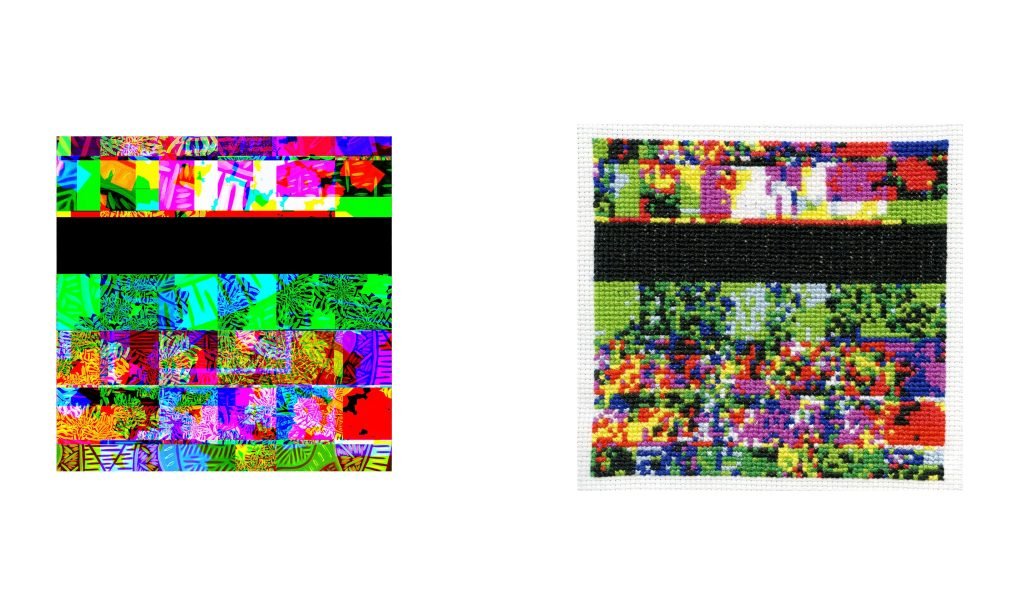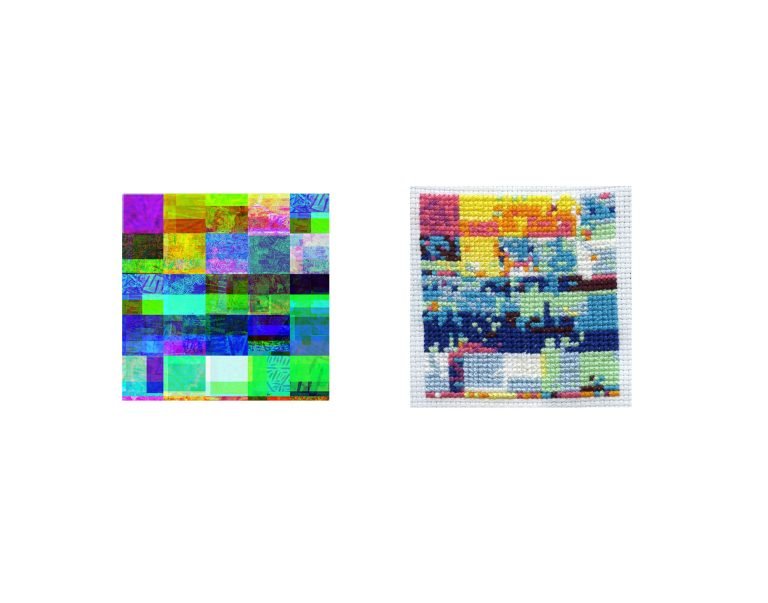February Interview: Mallory Donen
Our intention with this series is for readers to connect with the incredible artists in our space, consider craft through the lens of an artist and encourage people in their own journey with craft. The CCBC’s Artist Interview Series is published on the 15th of each month.
Could you tell us briefly what you make?
My practice is rooted in traditional craft processes passed down from generations of women in my family, including cross-stitching, crocheting, and knitting. I find inspiration from the aesthetics of digital art and computer glitches as a way of modernizing these crafts. By creating connections between  pixels and thread, my work activates conversations about both past, present, and future.
pixels and thread, my work activates conversations about both past, present, and future.
What inspired you to make your pieces, or how, conceptually, did your work come to be?
I was inspired to make my first cross-stitch pieces, since first learning how to cross-stitch from my mother (10-15 years prior), while I was completing my MFA at University of Manitoba. At the time of my degree, my practice was focused on making complex multi-layered patterns in Photoshop. I’ve always been drawn to pattern because of my love of repetition, consistency, and control. I started to become less concerned about what I was making, but rather how I was making. I created a book for my thesis exhibition, titled “Think Like a Human Act Like a Machine: Programming an Artist”, which focused entirely on an approach to making digital patterns through a series of pre-established instructions. I was interested in blurring the boundaries between artist and machine.
At this point, I began to think more about other processes and skills that follow patterns and instructions. That’s when the “Aha” moment happened, and I began my path towards a craft-based art practice. I created my cross-stitch series “When I Cross-Stitch I Feel Like a Machine” as part of my thesis exhibition “I Come From a Long Line of Machines”, the show title which was directly inspired by my grandmother who told me she felt like a machine while she was knitting. All the while not realizing that our worlds were colliding. Hers was knitting scarves for her grandchildren, mine was finger knitting a giant spiral yarn sculpture to install for my thesis!
Why do you make craft?
In a fast-paced society, so used to instant gratification through our digital devices, I find comfort in slowing down with the simplicity of craft. It helps me to appreciate and value my labour as an artist and as a woman. Slowing down amongst the chaos of the world, helps me to find a sense of calm on a daily basis. There’s also something so satisfying about spending weeks, sometimes months to complete a single work of art made entirely with my own hands, patience, and dedication to my craft. This means so much to me and I make it evident in the way I share my process and labour with the world. 
I use a stop-watch timer to document the time spent on my projects. I keep a note in my phone of labour logs as a way of making this often-invisible labour visible. When someone asks me “wow, how long did this take you to make?”, I pull out my phone or look at my artwork labels for reference and answer proudly “182 hours”! I share videos through social media as another way of making my labour visible, I always clearly note in the caption how much time was spent labouring over each project.
I believe in the importance of keeping the traditions of craft alive and thriving, by connecting with people in a modern way. That means sharing my craft with a wider audience and getting others excited to learn and understand that with a little bit of patience and practice they too could start using craft as their creative outlet or even simply for meditation.
Has your work evolved over time, if so, what has that looked like?
Oh yes, quite a lot! Throughout my childhood I explored all things creative including sketching, painting, cross-stitching, and taking photos with my camera. I did these things in my free time and never studied visual arts in high school. So, it wasn’t until the first year of my undergrad (at University of the Fraser Valley), that I was introduced to mediums that I had never explored before. I immediately shifted my studies into the BFA program where I focused in three studio disciplines: Photography, Painting/Drawing, and Print Media. But I also dabbled in Sculpture, New media, and Installation. My creative curiosity was never ending, and I knew that I wanted to be an artist for the rest of my life!
 I immediately attended University of Manitoba for a two-year MFA program, where I started with a focus in painting but quickly shifted gears towards making complex digital patterns. I would paint and draw quick sketches and studies which I would photograph/scan to use as reference material for my patterns. I printed large-scale Inkjet Fine Art prints, some as big as 5ft x 10ft long. I created an installation of 8 fabric banners (40” x 72” each) with a mesmerizing pattern printed on the surface to create an illusion of infinity and force the perspective of viewers within the installation. Then as mentioned earlier in the interview, I shifted my focus to instruction-based processes following patterns through knitting and cross-stitching. For the past 6 years I’ve dedicated most of my practice to traditional needlecraft techniques with an interest in the connection between digital and handmade. More recently I’ve been exploring more ideas around women’s labour in connection to craft.
I immediately attended University of Manitoba for a two-year MFA program, where I started with a focus in painting but quickly shifted gears towards making complex digital patterns. I would paint and draw quick sketches and studies which I would photograph/scan to use as reference material for my patterns. I printed large-scale Inkjet Fine Art prints, some as big as 5ft x 10ft long. I created an installation of 8 fabric banners (40” x 72” each) with a mesmerizing pattern printed on the surface to create an illusion of infinity and force the perspective of viewers within the installation. Then as mentioned earlier in the interview, I shifted my focus to instruction-based processes following patterns through knitting and cross-stitching. For the past 6 years I’ve dedicated most of my practice to traditional needlecraft techniques with an interest in the connection between digital and handmade. More recently I’ve been exploring more ideas around women’s labour in connection to craft.
Are there ideas, values, beliefs, or concepts that your work communicates? Could you tell us a bit more about that?
My practice investigates notions of labour, productivity, and the value of art in relation to craft and women’s work. I’ve been exploring this in more recent projects such as my book “Invisible Labour: Cross-Stitching, Feminism, & the Collective Strength of Women” and with my conceptual installation “Proofs of Labour”. Both projects embrace a conceptual approach to craft that emphasizes women’s invisible labour by making physical and emotional labours visible. Rather than focusing on making a tangible artwork or object, the importance for both these projects is the process itself. Whether it’s through the act of unstitching threads and documenting the process with labour logs or bringing women’s stories of triumph through hardships faced in a patriarchal society. These projects give the recognition and acknowledgment of women’s unseen labour that it truly deserves.
The lack of recognition of craft is a challenge I continue to face within the art world, which constantly tries to divide fine art from craft. I believe that both should exist in parallel, and that craft should not be disregarded or devalued, when it can be just as equal in skill and creativity as fine art.
What would you say to emerging or young craft artists?
Put in the work and never give up. Perseverance and passion are the two greatest skills of any artist. It’s not about skill or talent, those really don’t have as much importance. Never stop making and don’t get discouraged by rejection, 99% of the time it has nothing to do with your work and your value as an artist. If you are truly passionate about making art and you continue to share your ideas and projects with the world, then you are going to be a successful artist. Success looks different for everyone, so avoid comparing yourself to others. Write down short-term and long-term goals and celebrate all wins (no matter how small). This will keep you energized and help motivate you to strive for more in your practice.
discouraged by rejection, 99% of the time it has nothing to do with your work and your value as an artist. If you are truly passionate about making art and you continue to share your ideas and projects with the world, then you are going to be a successful artist. Success looks different for everyone, so avoid comparing yourself to others. Write down short-term and long-term goals and celebrate all wins (no matter how small). This will keep you energized and help motivate you to strive for more in your practice.
Remember half the battle is showing up! If you practice your art consistently, you’re already winning. Many people are too afraid to even try. It’s called an art “practice” for a reason, the truth is no one really knows what they’re doing. All artists practice, learn, and discover by pushing through the fear of not truly knowing if something will turn out in the end. I suggest embracing this fear and to keep doing what you’re most passionate about!
Mallory Donen
website | instagram | ccbc

images in order of appearance
- Live Cross Stitch demonstration, 2023
- Glitch Series 4, Crop #1, Mallory Donen
- Glitch Series 1, Crop #4, Mallory Donen
- Glitch Series 1, Crop #4, Mallory Donen
- Live Cross Stitch demonstration, 2023
- Live Cross Stitch demonstration, 2023
- Glitch Series 3, Crop # 6, Mallory Donen



